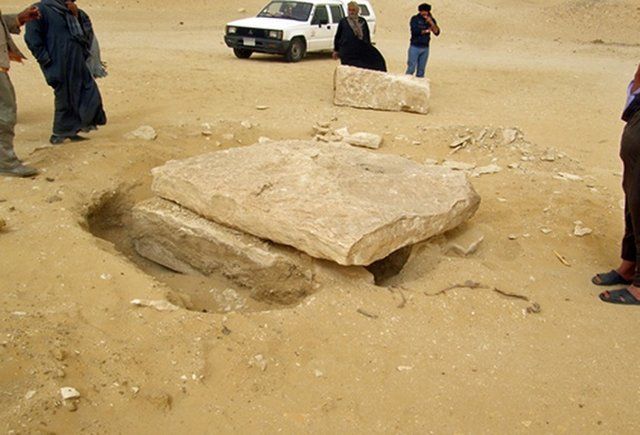This Amenemhat I carving dates back about 4,000 years and was discovered
near the pyramid of Amenemhat I.
Credit: Photo courtesy Mohamed Youssef Ali
Two massive limestone blocks decorated with hieroglyphs and carved images have been discovered beside the Pyramid of Amenemhat I at Lisht in Egypt.
Archaeologists led by Mohamed Youssef Ali, of Egypt's Ministry of Antiquities, rescued the blocks from looters who were digging near the pyramid.
The archaeologists essentially risked their lives to carry them out of the desert, an act that required both physical grit and ingenuity.
Pharaoh suckling a goddess
One of the blocks is nearly 5 feet by 2 feet (1.5 by 0.5 meters) and shows pharaoh Amenemhat I (reign circa 1981-1952 B.C.) suckling a goddess identified as the "Wadjet of Buto" in hieroglyphs engraved into the block. The fertility god Khnum stands beside the pharaoh and the goddess, saying, "I give to you water. The entourage of the gods," according to translated hieroglyphs.
The scene suggests that Khnum and the Wadjet of Buto are the parents of pharaoh Amenemhat I, Ali said. The "water" likely symbolizes Khnum's sperm, which impregnates the goddess, allowing for the pharaoh to be born, Ali said. Pharaohs are normally shown as adults and not infants, which may explain why Amenemhat is suckling the goddess even though he is depicted as a grown man.
This block was part of a larger carving. Another block from this carving was discovered at Lisht in 1908 by archaeologists with the Metropolitan Museum of Art. That block has an image of the sky god Horus on it.
Another limestone block near the pharaoh's was discovered and the block shows a group of six foreigners, perhaps Libyan men, with three children.
The block likely dates back centuries before the Amenemhat I block.
The men are bare-chested over short kilts, and have beards and long hair. There are no inscriptions on the block to inform us who these people were, and whether this scene relates to a specific event.
Rescue excavations in progress by the pyramid of Amenemhat I at Lisht.
Credit: Photo courtesy Mohamed Youssef Ali
Source: https://www.livescience.com/62468-ma...t-looting.html
peace...







 Reply With Quote
Reply With Quote
Bookmarks